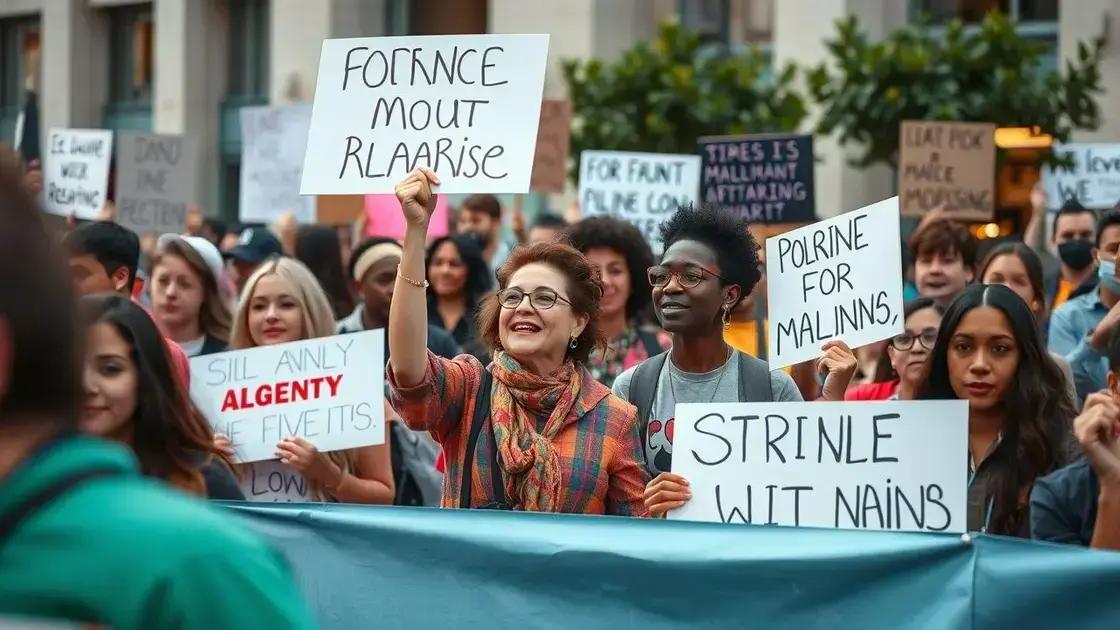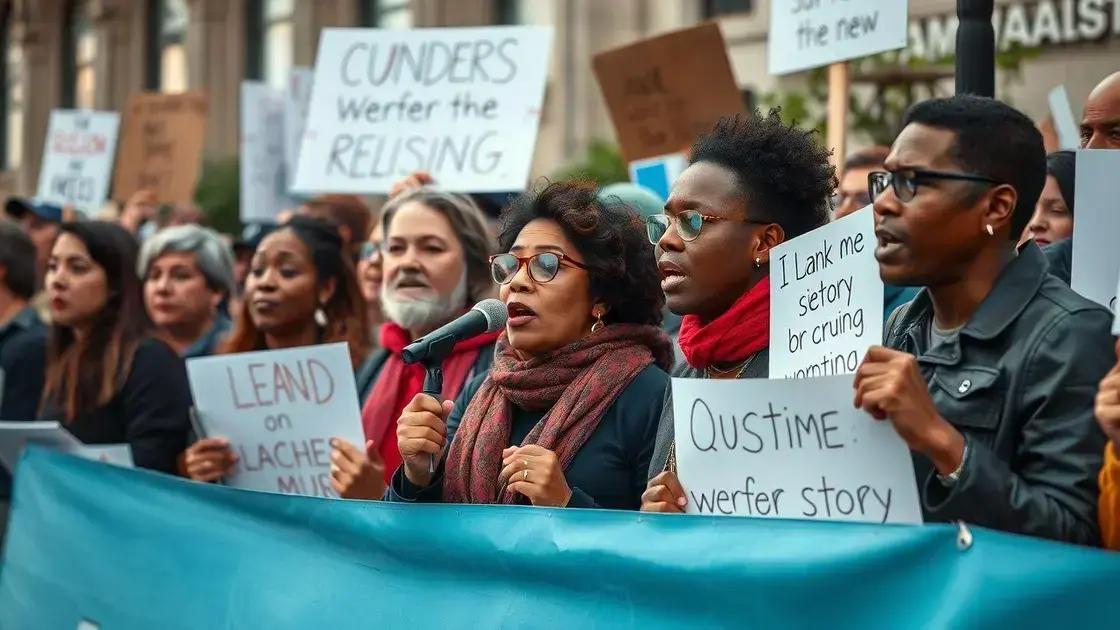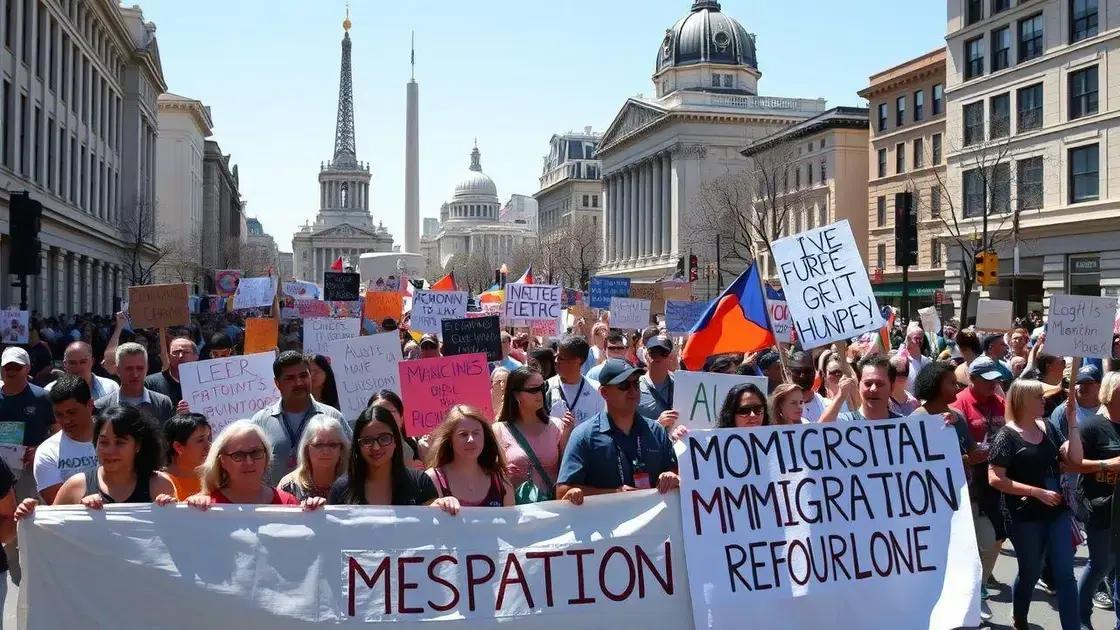Protesters rally in opposition to Trump-era regulations

Anúncios
Protesters rally in opposition to Trump-era regulations to address key issues like environmental protection, healthcare access, and workers’ rights, aiming to influence policy decisions and foster civic engagement.
Protesters rally in opposition to Trump-era regulations as they seek to voice their concerns over policies affecting their lives. These gatherings not only amplify individual voices but also highlight social issues that resonate widely. Have you ever wondered how these movements can shape our future?
Anúncios
Background of Trump-era regulations
The background of Trump-era regulations is crucial for understanding the protests today. These regulations span various sectors, from environmental policies to healthcare reforms. Many people feel that these changes are harmful and go against the well-being of the public.
Understanding Key Policies
One major focus has been on deregulation. The Trump administration aimed to reduce the number of federal regulations to promote businesses. However, many argue that this has come at the expense of public safety and environmental health.
Anúncios
- Environmental Deregulations: Rollbacks on pollution standards.
- Healthcare Changes: Reductions in protections for pre-existing conditions.
- Labor Regulations: Cuts to workplace safety protocols.
Additionally, these regulations have created a divide between different groups. Some citizens believe that prioritizing business over environmental and health safeguards is shortsighted. Communities that may be most affected by these changes are often the loudest in their opposition.
Historical Context
Understanding this background requires looking back at previous administrations. Regulations have often aimed to balance economic growth with public welfare. The shift under Trump marked a significant change in this balance.
This context is vital as protesters rally against what they see as harmful policies. They believe that the Trump-era regulations not only endanger the environment but also threaten their rights and health.
The result? A nationwide movement of people advocating for their voices to be heard. As the protests continue, the public is becoming more aware of these pivotal issues and their implications for the future.
Key issues driving protests
The key issues driving protests against Trump-era regulations are diverse and often interconnected. Activists are united by their concerns over various policies impacting their rights, health, and the environment. These issues resonate deeply within communities, prompting widespread mobilization and advocacy.
Environmental Concerns
One of the foremost issues is the environmental impact of deregulation. Many protestors argue that rolling back environmental protections endangers natural resources and public health.
- Increased air and water pollution.
- Threats to wildlife and natural habitats.
- Climate change inaction and its repercussions.
These environmental concerns drive many activists to the streets, advocating for policies that prioritize sustainability and health. They believe that the government has a responsibility to protect the environment and promote green initiatives.
Healthcare Accessibility
Another major issue is healthcare access. Protests often highlight the fear of losing coverage for pre-existing conditions. Many people worry that deregulated healthcare systems will leave them vulnerable and without necessary medical care.
This concern is not just about individual health; it also reflects broader societal values. Activists argue that quality healthcare is a right, not a privilege, and they seek to ensure that everyone has access to it.
Moreover, these protests are fueled by the voices of those affected. Families share personal stories, amplifying the urgency of their demands. When combined, these key issues create a powerful impetus for rallies and demonstrations across the country, driving home the message that regulation matters.
Voices from the protest frontlines

The voices from the protest frontlines tell powerful stories of resilience and hope. Many individuals participate in these rallies, each bringing their unique experiences and reasons for standing up against Trump-era regulations. These personal accounts add depth and urgency to the movement, showcasing the real human impact of policies.
Personal Experiences
At protests, you’ll find people like Sarah, a mother of two, who faces rising healthcare costs. “I can’t afford to have my child go without coverage,” she says passionately. Her story reflects concerns shared by many. Individuals unite under common issues, creating a strong community dedicated to each other’s rights.
- Stories of families affected by environmental changes.
- Individuals who have lost healthcare coverage.
- Workers facing job insecurities due to deregulation.
These voices echo the sentiments of thousands. Each protester has a narrative that connects to larger societal challenges. It’s not just about regulations; it’s about the lives they impact daily. Activists like John highlight injustices when they mention, “We are here because our voices matter. We deserve to be heard.” This passionate determination drives the movements forward.
The Power of Gathering
Being on the frontlines is empowering. When protesters gather, their collective energy radiates a message of unity. It’s not just about one person’s voice; it’s a symphony of dissent against policies perceived as harmful. The presence of diverse groups showing solidarity amplifies their message.
This communal strength leads to greater awareness. As protests grow, so does media coverage. People become more informed about the issues at stake. Activists see success when their concerns gain traction beyond their immediate communities. The voices from the protest frontlines attune society to such vital matters, pushing for change.
Impact of protests on policy debates
The impact of protests on policy debates has been significant, shaping the discussion around Trump-era regulations. These gatherings bring attention to pressing issues, influencing lawmakers and public opinion alike. When people take to the streets, they make their voices heard, pushing for change.
Shaping Legislative Priorities
Protests often highlight key issues that require immediate attention. Lawmakers cannot ignore the concerns raised by thousands of passionate citizens. For example, protests about healthcare can lead to renewed discussions about accessibility and affordability.
- Increased focus on healthcare policies.
- Heightened scrutiny of environmental regulations.
- Calls for comprehensive labor laws.
This kind of public pressure can lead to proposals for new laws or revisions of existing ones. It often pushes leaders to act more swiftly on issues that resonate with their constituents.
Influencing Public Discourse
The influence of protests extends beyond just policy discussions. They alter public discourse by bringing attention to injustices that might otherwise go unnoticed. Social media plays a crucial role here, as images and stories from protests spread rapidly.
This widespread visibility leads to greater awareness. People who may not have participated in the protests still engage in conversations about these topics. The result is a more informed public that advocates for change, holding officials accountable for their decisions.
As protests continue, they maintain a vital role in democratic processes. They ensure that the voices of the people are integrated into policy-making. The ongoing engagement between citizens and their representatives is essential for a healthy democracy.
Future implications of opposition movements
The future implications of opposition movements are crucial to consider, as they can shape the landscape of American politics and society. As protests continue to draw attention, they raise awareness about pressing issues. This engagement can lead to significant changes over time.
Long-term Change in Policies
One major implication is the potential for lasting changes in policies. When movements gain momentum, they can influence future legislation. Lawmakers pay attention to the needs of their constituents, leading to policies that reflect public sentiment.
- Increased environmental protections.
- Stronger healthcare guarantees.
- Workers’ rights and labor laws.
These changes may not happen overnight, but the pressure from organized groups can push leaders to implement reforms that align with the demands of the people.
Creating a More Engaged Citizenry
Protests also serve as a platform for civic engagement. When individuals participate in movements, they become more informed about political processes. This increased awareness encourages people to vote, campaign, and advocate for causes they believe in. A passionate citizenry can lead to a more active democracy.
Moreover, younger generations are stepping up to take action, indicating a shift toward a more engaged future. As these individuals grow and become leaders, their experiences with activism can inform their decisions.
The ripple effects of today’s movements can influence tomorrow’s leaders and policies. The lessons learned from protests are invaluable, shaping the values and priorities of future generations.
FAQ – Frequently Asked Questions about Protests and Policy Change
What are the main goals of the protests against Trump-era regulations?
The main goals include addressing environmental concerns, advocating for healthcare access, and promoting workers’ rights.
How do protests influence policy decisions?
Protests raise awareness about certain issues, pressuring lawmakers to consider public opinion when creating or altering policies.
What role does social media play in protests?
Social media helps spread awareness, share personal stories, and mobilize supporters, greatly amplifying the impact of the protests.
Can protests lead to long-term changes in society?
Yes, successful protests can lead to significant policy reforms and foster a more engaged citizenry, encouraging continuous advocacy.






